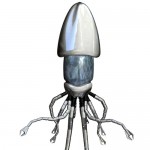
The first time I ever watched Transformers, my first thought was that the Decepticons were far cooler than the Autobots and my second thought was how amazing it would be to be able to change shape.
Since the days of Transformers (and before, if you count characters such as the Incredible Hulk), shape-shifters have been staples of science fiction and fantasy.
Every week I watch True Blood‘s Sam Malone turn into some kind of animal–a horse, a dog, a fly–and then strut around naked when he’s resumed his human form.
The liquid metal T-1000s from Terminator 2 top my list of most awesomely terrifying villains. And, of course, there are cuttlefish, octopi, and squid, who don’t need the hand of fiction to change color, shape, or size.
Everyone who’s tried to bend into a pretzel knows that unless David Icke is on to something, humans can’t shape-shift. But now, robots can.
The Maximum Mobility and Manipulation program at DARPA is funding research at Harvard University to emulate the qualities that benefit octopi and cuttlefish by creating soft robots that share many of the same abilities as their cephalopod inspirations–they change shape, temperature, and color, including patterns and luminescence. Unlike sea creatures, their camouflage abilities allow them to avoid detection by infrared cameras.
One advantage that sets these silicon robots apart from others is the price tag–they could be made for less than $100 each.
While scientists acknowledge that the speed is a drawback, their primary concern involves the robot’s flexibility and maneuverability. That focus has recently paid off, yielding encouraging results.
The real magic happens once the robot stops moving and turns up the juice–literally.
The capabilities of the robot come from microfluids, the basis of a new field currently impacting technological developments in a major way. Scientists learned that fluids behave differently on a microscopic scale than they do on a macroscopic scale, particularly when it comes to viscosity, the mixing of fluids (or lack thereof), and momentum. In DARPA’s robot, the microfluids run in narrow channels created inside a mold, and they control changes in color, shape, temperature, and movement. The current model has a tether that links the robot to a power source and allows scientists to inflate the channels and control the pressurization inside of them, which is what makes the robot’s coordinated movement possible.
Future versions will likely integrate the power source and the channel pumps with the robot itself, making it a self-contained unit.
Once these robots are self-contained, they could, at least theoretically, meet up with the cephalopods and take over the world.
I think I’ll just go ahead and put Optimus Prime on speed dial.

